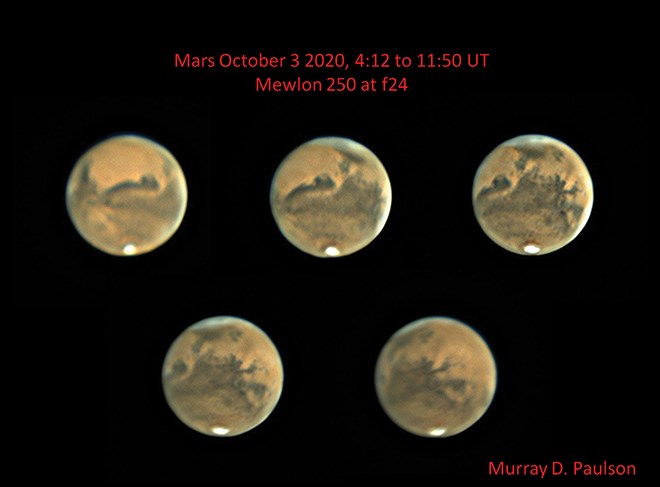Mercury was at inferior conjunction – between us and the Sun – on Oct. 25. By Nov. 4 it will be far enough west of the Sun to start being visible just before sunrise, say 6 a.m. The best way to find it is to look ESE where Venus is blazing away. Then look down and to the left about three quarters of the way to the horizon and find a pair of objects. The brighter one on the left is Mercury; the one on the right is Spica, the brightest star in Virgo. If you’re both fortunate and masochistic enough you may be able to watch Spica head slowly up and to the right morning by morning as our vantage point circles around the Sun. On the mornings of the 12th and 13th, Venus and Mercury will be joined by a thin waning crescent Moon.
While having Venus close will really help in making Mercury identifiable, this isn’t one of its better appearances. Its orbit is elliptical and perihelion – closest approach to the Sun – was Nov. 2 so it’s about as close to the Sun as it gets. While Mercury’s maximum elongation – distance east or west of the Sun – ranges from 18 to 28 degrees, this time around it’s only 19 degrees.
As well, that waning crescent moon from the 12th and 13th reaches perigee – closest approach to Earth – on the 14th and is a New Moon only 17 hours later. Big tidal range, folks! Two weeks later, the full Moon goes partly through Earth’s shadow in a penumbral eclipse; all but the southern edge of the Moon will be partly shadowed by Earth so it will be much more subtle than an umbral eclipse where all the Moon is within Earth’s shadow cone. Trivia note (and new astronomy word of the month): the linear alignment of Earth, Moon and Sun is called syzygy, which is apparently of ancient Greek origin. (Since I learned that, every time I played Scrabble I secretly hoped I’d get the tiles and the chance to play that on a triple word score square. It was years before I realized there are only two tiles with “y” on them. Using a blank just wouldn’t feel the same.)
Mars is still big and bright although it’s starting to shrink since we passed it Oct. 13. Its maximum size was 22.57 arcseconds on Oct. 6 and it’s down to about 20 by Nov. 1. Still worth a look with a clear sky and a good scope.
Jupiter and Saturn are low in the south after sunset, after their opposition in late July and are approaching each other during November en route to their spectacular conjunction on Dec. 21. They will pass each other about 0.1 degree apart – about 1/5 the width of the Moon – in their closest approach since 1623! The “Heavens Above” website at www.heavens-above.com will show you a star chart for anyplace/anytime to check out all the above events, as well as a lot of other info. The next Zoom meeting of the Astronomy Club should be Nov. 13 at 7 p.m. The club website at: https://sunshinecoastastronomy.wordpress.com/ will have information on the speaker and topic and how to register for the meeting the week before the meeting.
Sechelt SKIES, Richard Corbet



